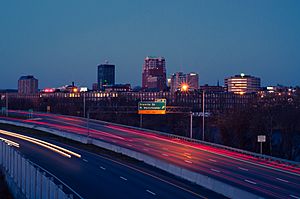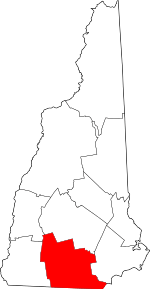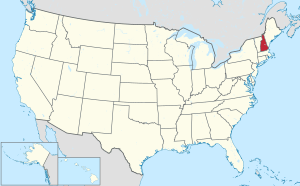Hillsborough County, New Hampshire facts for kids
Quick facts for kids
Hillsborough County
|
||
|---|---|---|

Manchester skyline
|
||
|
||

Location within the U.S. state of New Hampshire
|
||
 New Hampshire's location within the U.S. |
||
| Country | ||
| State | ||
| Founded | 1769 | |
| Named for | The Earl of Hillsborough | |
| Seat | Manchester and Nashua | |
| Largest city | Manchester (by population) Weare (by area) |
|
| Area | ||
| • Total | 892.5 sq mi (2,312 km2) | |
| • Land | 876.5 sq mi (2,270 km2) | |
| • Water | 15.9 sq mi (41 km2) 1.8% | |
| Population
(2020)
|
||
| • Total | 422,937 | |
| • Estimate
(2022)
|
426,594 |
|
| • Density | 486.7/sq mi (187.9/km2) | |
| Time zone | UTC−5 (Eastern) | |
| • Summer (DST) | UTC−4 (EDT) | |
| Congressional districts | 1st, 2nd | |
Hillsborough County is the most populous county in the U.S. state of New Hampshire. As of the 2020 census, the population was 422,937, almost one-third the population of the entire state. Its county seats are Manchester and Nashua, the state's two biggest cities. Hillsborough is northern New England's most populous county as well as its most densely populated.
Hillsborough County comprises the Manchester-Nashua, NH Metropolitan Statistical Area, which in turn constitutes a portion of the Boston-Worcester-Providence, MA-RI-NH-CT Combined Statistical Area.
Contents
History
Hillsborough was one of the five original counties identified for the old Province of New Hampshire in 1769, and was named for Wills Hill, 1st Earl of Hillsborough, who was British Secretary of State for the Colonies at the time. The county was formally organized at Amherst on March 19, 1771.
In 1823, twelve townships of Hillsborough Country – Andover, Boscawen, Bradford, Dunbarton, Fishersfield (now Newbury), Henniker, Hooksett, Hopkinton, New London, Salisbury, Sutton, and Warner – became part of Merrimack County. The town of Merrimack along the Merrimack River in south-central Hillsborough County was not included in the newly formed county 9 miles (14 km) to the north. Hillsborough County's administrative functions were moved from Amherst to Milford in 1866, and then to the current seats of Manchester and Nashua in 1869.
Geography
According to the United States Census Bureau, the county has a total area of 892 square miles (2,310 km2), of which 876 square miles (2,270 km2) is land and 16 square miles (41 km2) (1.8%) is water. The highest point in Hillsborough county is Pack Monadnock Mountain at 2,290 feet (700 m).
Adjacent counties
- Merrimack County (north)
- Rockingham County (east)
- Essex County, Massachusetts (southeast)
- Middlesex County, Massachusetts (south)
- Worcester County, Massachusetts (southwest)
- Cheshire County (west)
- Sullivan County (northwest)
National protected area
- Wapack National Wildlife Refuge
Demographics
| Historical population | |||
|---|---|---|---|
| Census | Pop. | %± | |
| 1790 | 32,883 | — | |
| 1800 | 43,899 | 33.5% | |
| 1810 | 49,249 | 12.2% | |
| 1820 | 53,884 | 9.4% | |
| 1830 | 37,724 | −30.0% | |
| 1840 | 42,494 | 12.6% | |
| 1850 | 57,478 | 35.3% | |
| 1860 | 62,140 | 8.1% | |
| 1870 | 64,238 | 3.4% | |
| 1880 | 75,634 | 17.7% | |
| 1890 | 93,247 | 23.3% | |
| 1900 | 112,640 | 20.8% | |
| 1910 | 126,072 | 11.9% | |
| 1920 | 135,512 | 7.5% | |
| 1930 | 140,165 | 3.4% | |
| 1940 | 144,888 | 3.4% | |
| 1950 | 156,987 | 8.4% | |
| 1960 | 178,161 | 13.5% | |
| 1970 | 223,941 | 25.7% | |
| 1980 | 276,608 | 23.5% | |
| 1990 | 336,073 | 21.5% | |
| 2000 | 380,841 | 13.3% | |
| 2010 | 400,721 | 5.2% | |
| 2020 | 422,937 | 5.5% | |
| 2022 (est.) | 426,594 | 6.5% | |
| U.S. Decennial Census 1790–1960 1900–1990 1990–2000 2010–2020 |
|||
2020 census
| Race | Percentage |
|---|---|
| White, not Hispanic or Latino | 83% |
| Asian | 6% |
| Hispanic or Latino | 8% |
| Black or African American | 3% |
As of the census of 2020, there were 422,937 people residing in the county. The population density was 482.8 inhabitants per square mile (186.4/km2).
The racial makeup of the county was 81.0% white, 4.8% Asian, 3.9% black or African American, 1.7% American Indian, 2.1% from other races, and 2.0% from two or more races. Those of Hispanic or Latino origin made up 8% of the population.
For the period 2011–2015, 24.8% of the county's population had French ancestry (including 9.9% of the total population with French Canadian ancestry), 20.9% had Irish, 13.1% had English, 10.2% had Italian, and 8.2% had German ancestry. For the same time period, the estimated median annual income for a household in the county was $71,244, and the median income for a family was $85,966. Male full-time workers had a median income of $60,349 versus $44,270 for females. The per capita income for the county was $35,242. About 5.8% of families and 8.8% of the population were below the poverty line, including 11.7% of those under age 18 and 5.9% of those age 65 or over.
Communities
Cities
- Manchester (county seat)
- Nashua (county seat)
Towns
Census-designated places
- Amherst
- Antrim
- Bennington
- East Merrimack
- Francestown
- Goffstown
- Greenville
- Hancock
- Hillsborough
- Hudson
- Klondike Corner
- Milford
- New Boston
- Peterborough
- Pinardville
- Wilton
Villages
Former towns
- Monson
Education
School districts include:
K-12 districts:
- Bedford School District
- Contoocook Valley School District
- Goffstown School District
- Hillsboro-Deering Cooperative School District
- Hudson School District
- Litchfield School District
- Manchester School District
- Mascenic Regional School District
- Merrimack School District
- Milford School District
- Nashua School District
- Pelham School District
- Wilton-Lyndeborough School District
- Windsor School District
Secondary districts:
- Hollis-Brookline Cooperative School District
- Souhegan Cooperative School District
- John Stark Regional School District
Elementary districts:
- Amherst School District
- Brookline School District
- Hollis School District
- Mason School District
- Mont Vernon School District
- New Boston School District
- Weare School District
Previously Bedford sent high school students to the Manchester School District.
See also
 In Spanish: Condado de Hillsborough (Nuevo Hampshire) para niños
In Spanish: Condado de Hillsborough (Nuevo Hampshire) para niños


